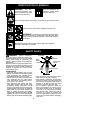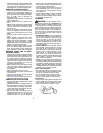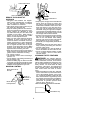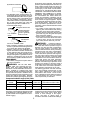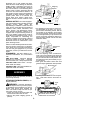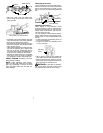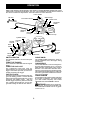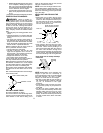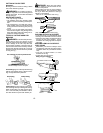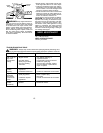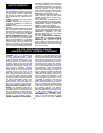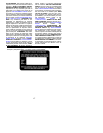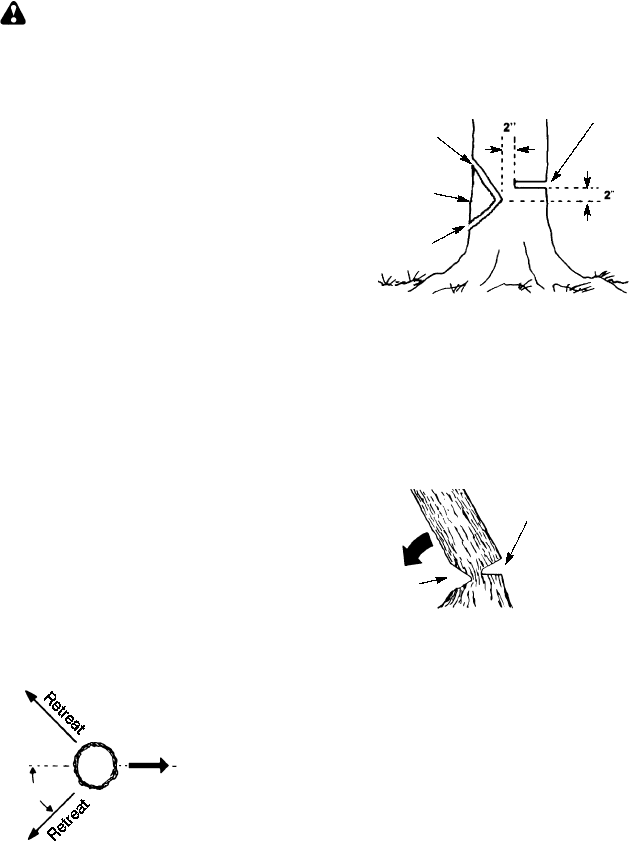
11
S
Releasethethrottletriggerassoon asthe
cut is completed, allowing the engine to
idle. If you run thesaw at full throttlewith-
out acuttingload, unnecessar y w earcan
occur to the chain, bar and engine.
S
Toavoid losing control whencut iscom-
plete, donot putpressure onsaw atend
of cut.
S
Stopthe enginebeforesettingthesawdown.
TREE FELLING TECHNIQUES
WARNING:
Check for broken or
dead branches which can fall while cutting
causing serious injury. Donot cut nearbuild-
ings or electrical wires if you donot know the
direction of tree fall, at night sinceyou willnot
be able to see well, or during bad weather
such as rain, snow, or strong winds, etc. If
tree makes contact with any utility line, the
utility company should be notified immedi-
ately.
S
Carefully plan yoursawing operation inad-
vance.
S
Cleartheworkarea. You needa cleararea
all around the tree so you can have secure
footing.
S
The chain saw operator should keep on
the uphill side of the terrain as the tree is
likely toroll orslidedownhill after it isfelled.
S
Study the natural conditions that can cause
the tr ee to fall in a particular direction.
Natural conditions that can cause a tree to
fall in a particular direction include:
S
The wind direction and speed.
S
The lean of the tree. The lean of a tree
might not be apparent due to uneven or
sloping terrain. Usea plumb or level to de-
termine the direction of tree lean.
S
Weight and branches on one side.
S
Surrounding trees and obstacles.
Look for decay and rot. If the trunk is r otted, it
can snap and fall toward the oper ator.
Make sure there is enough r oom for the treeto
fall. Maintain a dis ta nc e o f
2-1/2
tree lengths
from the near est per son or other objects. En-
gine noise can drown out a warning call.
Removedirt, stones, loose bark, nails, staples,
and w ire from the tree w her e c uts ar e to be
made.
Plan a clear retreat path to the rear and diago-
nal to the lin e of fall.
Direction of Fall
45
_
Plan a clear retreat path
FELLING LARGE TREES
(6 inches in diameter or larger)
The notch method is used to fell large trees.
Anotch is cut onthe side ofthe tree inthe de-
sired direction of fall. After a felling cut is
made on the opposite side o f tree, the tree
will tend to fall into the notch.
NOTE
: If the tree has large buttress roots,
remove them before making the notch. If us-
ing saw to remove buttress roots, keep saw
chain from contacting ground toprevent dull-
ing of the chain.
NOTCH CUT AND FELLING THE
TREE
S
Make notch cut by cutting the top of the
notch first. Cut through
1/3
of the diameter
ofthe tree. Nextcomplete the notch bycut-
ting the bottom of the notch. See illustra-
tion. Once the notch is cut remove the
notch of wood from the tree.
Notch
First cut
Second cut
Final cut here 2 inches
above center of notch.
S
After r emoving the wood from the notch,
make thefelling cuton the opposite side of
the notch. This is done by making a cut
about two inches higher than the center of
the notch. This will leave enough uncut
woodbetween the felling cut and thenotch
toform ahinge. This hinge will helpprevent
the tree from falling in the wrong direction.
Opening
of felling
cut
Closing o f
notch
Hinge holds tree on stump and helps
control fall
NOTE
: Before felling cut is complete, use
wedges to open the cut if nec essary to
control the direction of fall. To avoid kickback
and chain damage, use wood or plastic
wedges, but never steel or iron wedges.
S
Be alert to signs that the tree is ready to
fall: cracking sounds, widening of the fell-
ing cut, or movement in the upper
branches.
S
As tree starts to fall, stop saw, put it down,
and get away quickly on your planned re-
treat path.
S
DO NOT cut down a partially fallen tree
with your saw. Beextremely cautious with
partially fallen trees that may be poorly
supported. When a tree doesn’t fall com-
pletely,set thesawaside andpull down the
tree with a cable winch, block and tackle,
or tractor.



